battery replacement CHEVROLET CAMARO SS 2010 Owners Manual
[x] Cancel search | Manufacturer: CHEVROLET, Model Year: 2010, Model line: CAMARO SS, Model: CHEVROLET CAMARO SS 2010Pages: 372, PDF Size: 1.91 MB
Page 9 of 372
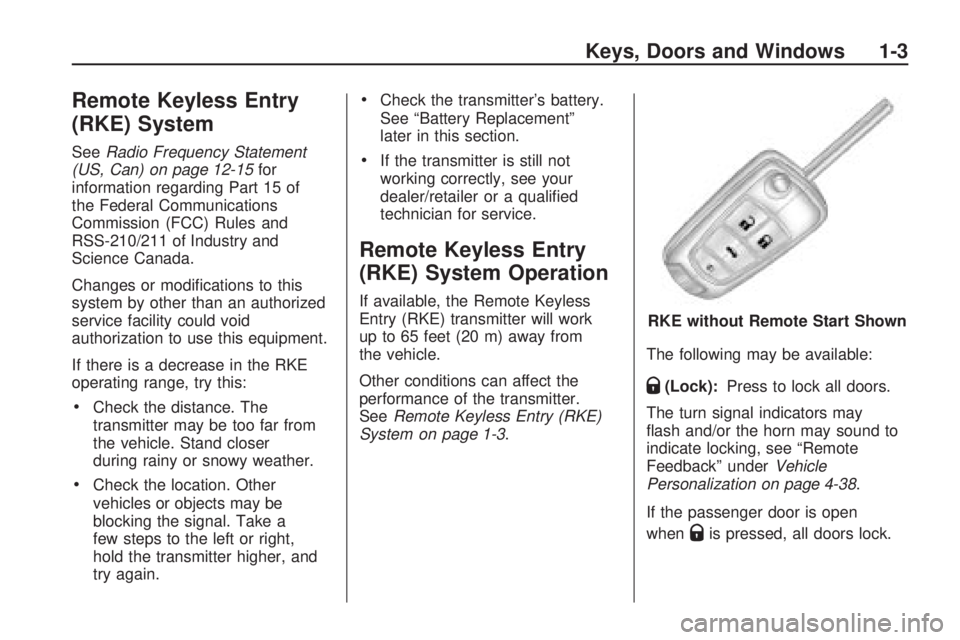
Remote Keyless Entry
(RKE) System
SeeRadio Frequency Statement
(US, Can) on page 12-15for
information regarding Part 15 of
the Federal Communications
Commission (FCC) Rules and
RSS-210/211 of Industry and
Science Canada.
Changes or modifications to this
system by other than an authorized
service facility could void
authorization to use this equipment.
If there is a decrease in the RKE
operating range, try this:
•Check the distance. The
transmitter may be too far from
the vehicle. Stand closer
during rainy or snowy weather.
•Check the location. Other
vehicles or objects may be
blocking the signal. Take a
few steps to the left or right,
hold the transmitter higher, and
try again.
•Check the transmitter’s battery.
See “Battery Replacement”
later in this section.
•If the transmitter is still not
working correctly, see your
dealer/retailer or a qualified
technician for service.
Remote Keyless Entry
(RKE) System Operation
If available, the Remote Keyless
Entry (RKE) transmitter will work
up to 65 feet (20 m) away from
the vehicle.
Other conditions can affect the
performance of the transmitter.
SeeRemote Keyless Entry (RKE)
System on page 1-3.The following may be available:
Q(Lock):Press to lock all doors.
The turn signal indicators may
flash and/or the horn may sound to
indicate locking, see “Remote
Feedback” underVehicle
Personalization on page 4-38.
If the passenger door is open
when
Qis pressed, all doors lock. RKE without Remote Start Shown
Keys, Doors and Windows 1-3
Page 10 of 372
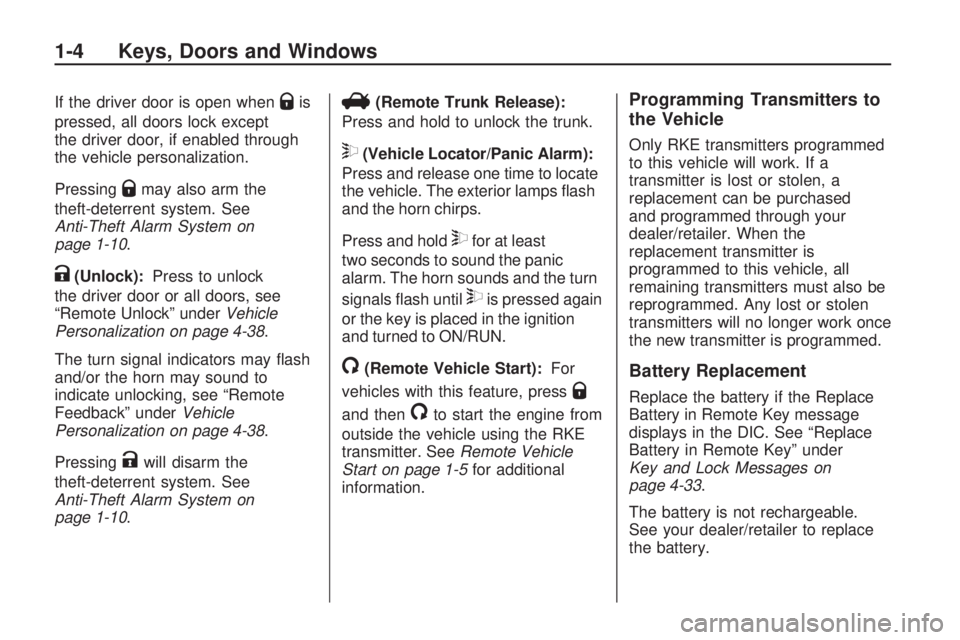
If the driver door is open whenQis
pressed, all doors lock except
the driver door, if enabled through
the vehicle personalization.
Pressing
Qmay also arm the
theft-deterrent system. See
Anti-Theft Alarm System on
page 1-10.
K(Unlock):Press to unlock
the driver door or all doors, see
“Remote Unlock” underVehicle
Personalization on page 4-38.
The turn signal indicators may flash
and/or the horn may sound to
indicate unlocking, see “Remote
Feedback” underVehicle
Personalization on page 4-38.
Pressing
Kwill disarm the
theft-deterrent system. See
Anti-Theft Alarm System on
page 1-10.
V(Remote Trunk Release):
Press and hold to unlock the trunk.
7(Vehicle Locator/Panic Alarm):
Press and release one time to locate
the vehicle. The exterior lamps flash
and the horn chirps.
Press and hold
7for at least
two seconds to sound the panic
alarm. The horn sounds and the turn
signals flash until
7is pressed again
or the key is placed in the ignition
and turned to ON/RUN.
/(Remote Vehicle Start):For
vehicles with this feature, press
Q
and then/to start the engine from
outside the vehicle using the RKE
transmitter. SeeRemote Vehicle
Start on page 1-5for additional
information.
Programming Transmitters to
the Vehicle
Only RKE transmitters programmed
to this vehicle will work. If a
transmitter is lost or stolen, a
replacement can be purchased
and programmed through your
dealer/retailer. When the
replacement transmitter is
programmed to this vehicle, all
remaining transmitters must also be
reprogrammed. Any lost or stolen
transmitters will no longer work once
the new transmitter is programmed.
Battery Replacement
Replace the battery if the Replace
Battery in Remote Key message
displays in the DIC. See “Replace
Battery in Remote Key” under
Key and Lock Messages on
page 4-33.
The battery is not rechargeable.
See your dealer/retailer to replace
the battery.
1-4 Keys, Doors and Windows
Page 89 of 372
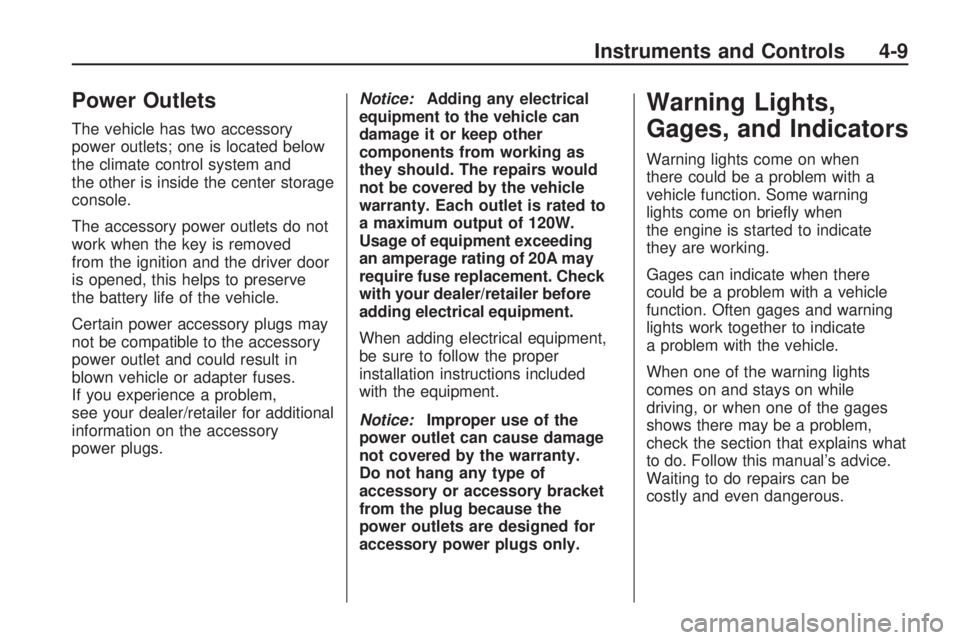
Power Outlets
The vehicle has two accessory
power outlets; one is located below
the climate control system and
the other is inside the center storage
console.
The accessory power outlets do not
work when the key is removed
from the ignition and the driver door
is opened, this helps to preserve
the battery life of the vehicle.
Certain power accessory plugs may
not be compatible to the accessory
power outlet and could result in
blown vehicle or adapter fuses.
If you experience a problem,
see your dealer/retailer for additional
information on the accessory
power plugs.Notice:Adding any electrical
equipment to the vehicle can
damage it or keep other
components from working as
they should. The repairs would
not be covered by the vehicle
warranty. Each outlet is rated to
a maximum output of 120W.
Usage of equipment exceeding
an amperage rating of 20A may
require fuse replacement. Check
with your dealer/retailer before
adding electrical equipment.
When adding electrical equipment,
be sure to follow the proper
installation instructions included
with the equipment.
Notice:Improper use of the
power outlet can cause damage
not covered by the warranty.
Do not hang any type of
accessory or accessory bracket
from the plug because the
power outlets are designed for
accessory power plugs only.
Warning Lights,
Gages, and Indicators
Warning lights come on when
there could be a problem with a
vehicle function. Some warning
lights come on briefly when
the engine is started to indicate
they are working.
Gages can indicate when there
could be a problem with a vehicle
function. Often gages and warning
lights work together to indicate
a problem with the vehicle.
When one of the warning lights
comes on and stays on while
driving, or when one of the gages
shows there may be a problem,
check the section that explains what
to do. Follow this manual’s advice.
Waiting to do repairs can be
costly and even dangerous.
Instruments and Controls 4-9
Page 233 of 372

Vehicle Care
General InformationGeneral Information...............9-2
California Proposition 65
Warning.............................9-2
California Perchlorate
Materials Requirements........9-3
Accessories and
Modifications.......................9-3
Vehicle ChecksDoing Your Own
Service Work......................9-4
Hood...................................9-5
Engine Compartment
Overview............................9-6
Engine Cover.......................9-9
Engine Oil..........................9-10
Engine Oil Life System.........9-13
Automatic Transmission
Fluid................................9-14
Manual Transmission Fluid. . . .9-15
Hydraulic Clutch..................9-15
Engine Air Cleaner/Filter.......9-16
Cooling System...................9-17
Engine Coolant...................9-19
Engine Overheating.............9-24
Power Steering Fluid............9-25Washer Fluid......................9-26
Brakes...............................9-27
Brake Fluid.........................9-28
Battery...............................9-29
Rear Axle...........................9-30
Starter Switch Check............9-31
Automatic Transmission
Shift Lock Control
System Check...................9-32
Ignition Transmission
Lock Check.......................9-32
Park Brake and P (Park)
Mechanism Check..............9-32
Wiper Blade Replacement......9-33Headlamp AimingHeadlamp Aiming................9-34
Bulb ReplacementBulb Replacement...............9-37
Halogen Bulbs....................9-37
High Intensity Discharge
(HID) Lighting....................9-37
Headlamps, Front Turn
Signal and Parking Lamps
(Base Vehicle)...................9-37
Headlamps, Front Turn
Signal and Parking Lamps
(Up-Level Vehicle)..............9-38
Daytime Running
Lamps (DRL)....................9-39
Fog Lamps.........................9-40Taillamps, Turn Signal, and
Stoplamps.........................9-40
License Plate Lamp.............9-40
Replacement Bulbs..............9-41
Electrical SystemElectrical System
Overload...........................9-41
Fuses and Circuit
Breakers...........................9-42
Engine Compartment
Fuse Block.......................9-42
Instrument Panel
Fuse Block.......................9-45
Rear Compartment
Fuse Block.......................9-46
Wheels and TiresTires..................................9-48
Winter Tires........................9-48
Tire Sidewall Labeling..........9-49
Tire Designations.................9-51
Tire Terminology and
Definitions.........................9-52
Tire Pressure......................9-54
Tire Pressure for
High-Speed Operation........9-56
Tire Pressure Monitor
System.............................9-56
Tire Pressure Monitor
Operation..........................9-57
Tire Inspection....................9-61
Vehicle Care 9-1
Page 261 of 372
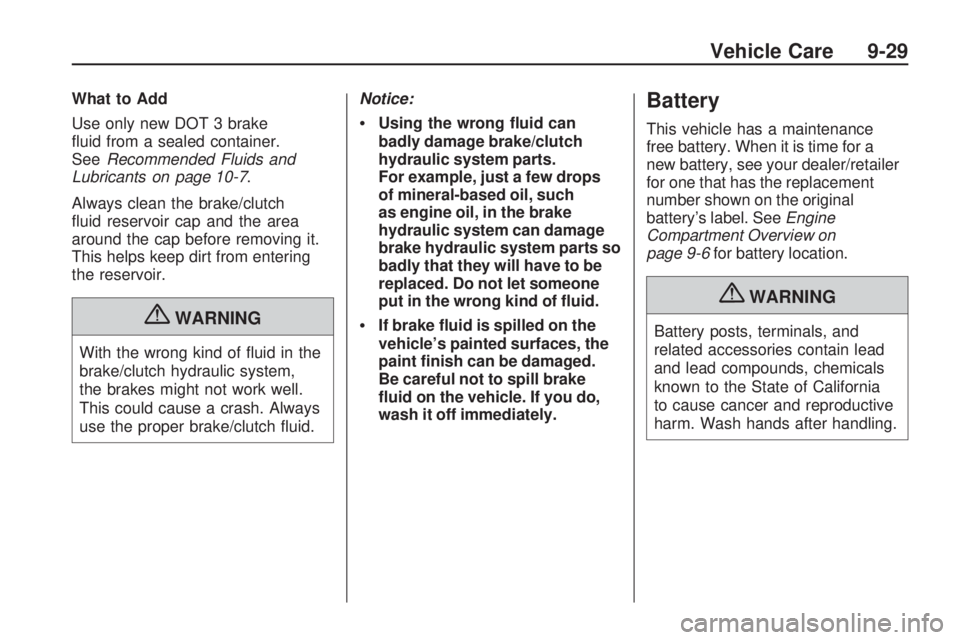
What to Add
Use only new DOT 3 brake
fluid from a sealed container.
SeeRecommended Fluids and
Lubricants on page 10-7.
Always clean the brake/clutch
fluid reservoir cap and the area
around the cap before removing it.
This helps keep dirt from entering
the reservoir.
{WARNING
With the wrong kind of fluid in the
brake/clutch hydraulic system,
the brakes might not work well.
This could cause a crash. Always
use the proper brake/clutch fluid.Notice:
Using the wrong �uid can
badly damage brake/clutch
hydraulic system parts.
For example, just a few drops
of mineral-based oil, such
as engine oil, in the brake
hydraulic system can damage
brake hydraulic system parts so
badly that they will have to be
replaced. Do not let someone
put in the wrong kind of �uid.
If brake �uid is spilled on the
vehicle’s painted surfaces, the
paint �nish can be damaged.
Be careful not to spill brake
�uid on the vehicle. If you do,
wash it off immediately.
Battery
This vehicle has a maintenance
free battery. When it is time for a
new battery, see your dealer/retailer
for one that has the replacement
number shown on the original
battery’s label. SeeEngine
Compartment Overview on
page 9-6for battery location.
{WARNING
Battery posts, terminals, and
related accessories contain lead
and lead compounds, chemicals
known to the State of California
to cause cancer and reproductive
harm. Wash hands after handling.
Vehicle Care 9-29
Page 351 of 372

•Flat Tire Change:Service is
provided to change a flat tire
with the spare tire. The spare tire,
if equipped, must be in good
condition and properly inflated.
It is the owner’s responsibility for
the repair or replacement of
the tire if it is not covered by the
warranty.
•Battery Jump Start:Service is
provided to jump start a dead
battery.
Services Not Included in
Roadside Assistance
•
Impound towing caused by
violation of any laws.
•Legal fines.
•Mounting, dismounting or
changing of snow tires, chains,
or other traction devices.
•Towing or services for vehicles
driven on a non-public road or
highway.
Services Speci�c to Canadian
Purchased Vehicles
•
Fuel delivery:Reimbursement is
approximately $5 Canadian.
Diesel fuel delivery may
be restricted. Propane and other
fuels are not provided through
this service.
•Lock-Out Service:Vehicle
registration is required.
•Trip Routing Service:Detailed
maps of North America are
provided when requested either
with the most direct route or
the most scenic route. There is a
limit of six requests per year.
Additional travel information
is also available. Allow
three weeks for delivery.
•Trip Interruption Bene�ts
and Assistance:Must be
over 250 kilometres from
where your trip was started to
qualify. General Motors of
Canada Limited requires
pre-authorization, originaldetailed receipts, and a copy
of the repair orders. Once
authorization has been received,
the Roadside Assistance
advisor will help you make
arrangements and explain how to
receive payment.
•Alternative Service:If
assistance cannot be provided
right away, the Roadside
Assistance advisor may give
you permission to get local
emergency road service. You will
receive payment, up to $100,
after sending the original receipt
to Roadside Assistance.
Mechanical failures may be
covered, however any cost for
parts and labor for repairs
not covered by the warranty are
the owner responsibility.
Customer Information 12-7
Page 361 of 372
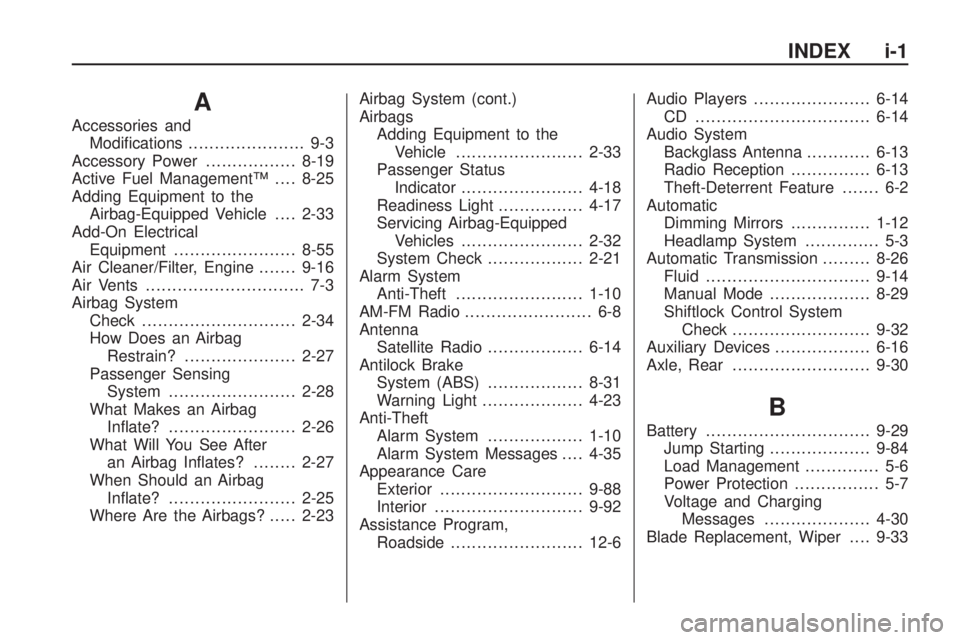
A
Accessories and
Modifications...................... 9-3
Accessory Power.................8-19
Active Fuel Management™....8-25
Adding Equipment to the
Airbag-Equipped Vehicle....2-33
Add-On Electrical
Equipment.......................8-55
Air Cleaner/Filter, Engine.......9-16
Air Vents.............................. 7-3
Airbag System
Check.............................2-34
How Does an Airbag
Restrain?.....................2-27
Passenger Sensing
System........................2-28
What Makes an Airbag
Inflate?........................2-26
What Will You See After
an Airbag Inflates?........2-27
When Should an Airbag
Inflate?........................2-25
Where Are the Airbags?.....2-23Airbag System (cont.)
Airbags
Adding Equipment to the
Vehicle........................2-33
Passenger Status
Indicator.......................4-18
Readiness Light................4-17
Servicing Airbag-Equipped
Vehicles.......................2-32
System Check..................2-21
Alarm System
Anti-Theft........................1-10
AM-FM Radio........................ 6-8
Antenna
Satellite Radio..................6-14
Antilock Brake
System (ABS)..................8-31
Warning Light...................4-23
Anti-Theft
Alarm System..................1-10
Alarm System Messages....4-35
Appearance Care
Exterior...........................9-88
Interior............................9-92
Assistance Program,
Roadside.........................12-6Audio Players......................6-14
CD .................................6-14
Audio System
Backglass Antenna............6-13
Radio Reception...............6-13
Theft-Deterrent Feature....... 6-2
Automatic
Dimming Mirrors...............1-12
Headlamp System.............. 5-3
Automatic Transmission.........8-26
Fluid...............................9-14
Manual Mode...................8-29
Shiftlock Control System
Check..........................9-32
Auxiliary Devices..................6-16
Axle, Rear..........................9-30
B
Battery...............................9-29
Jump Starting...................9-84
Load Management.............. 5-6
Power Protection................ 5-7
Voltage and Charging
Messages....................4-30
Blade Replacement, Wiper....9-33
INDEX i-1
Page 368 of 372
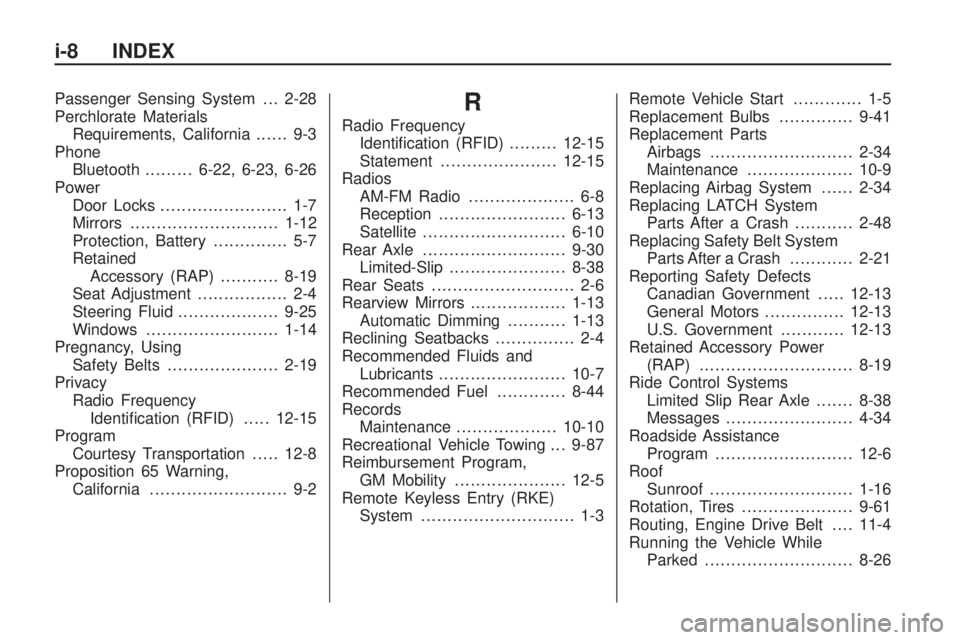
Passenger Sensing System . . . 2-28
Perchlorate Materials
Requirements, California...... 9-3
Phone
Bluetooth.........6-22, 6-23, 6-26
Power
Door Locks........................ 1-7
Mirrors............................1-12
Protection, Battery.............. 5-7
Retained
Accessory (RAP)...........8-19
Seat Adjustment................. 2-4
Steering Fluid...................9-25
Windows.........................1-14
Pregnancy, Using
Safety Belts.....................2-19
Privacy
Radio Frequency
Identification (RFID).....12-15
Program
Courtesy Transportation.....12-8
Proposition 65 Warning,
California.......................... 9-2R
Radio Frequency
Identification (RFID).........12-15
Statement......................12-15
Radios
AM-FM Radio.................... 6-8
Reception........................6-13
Satellite...........................6-10
Rear Axle...........................9-30
Limited-Slip......................8-38
Rear Seats........................... 2-6
Rearview Mirrors..................1-13
Automatic Dimming...........1-13
Reclining Seatbacks............... 2-4
Recommended Fluids and
Lubricants........................10-7
Recommended Fuel.............8-44
Records
Maintenance...................10-10
Recreational Vehicle Towing . . . 9-87
Reimbursement Program,
GM Mobility.....................12-5
Remote Keyless Entry (RKE)
System............................. 1-3Remote Vehicle Start............. 1-5
Replacement Bulbs..............9-41
Replacement Parts
Airbags...........................2-34
Maintenance....................10-9
Replacing Airbag System......2-34
Replacing LATCH System
Parts After a Crash...........2-48
Replacing Safety Belt System
Parts After a Crash............2-21
Reporting Safety Defects
Canadian Government.....12-13
General Motors...............12-13
U.S. Government............12-13
Retained Accessory Power
(RAP) .............................8-19
Ride Control Systems
Limited Slip Rear Axle.......8-38
Messages........................4-34
Roadside Assistance
Program..........................12-6
Roof
Sunroof...........................1-16
Rotation, Tires.....................9-61
Routing, Engine Drive Belt....11-4
Running the Vehicle While
Parked............................8-26
i-8 INDEX